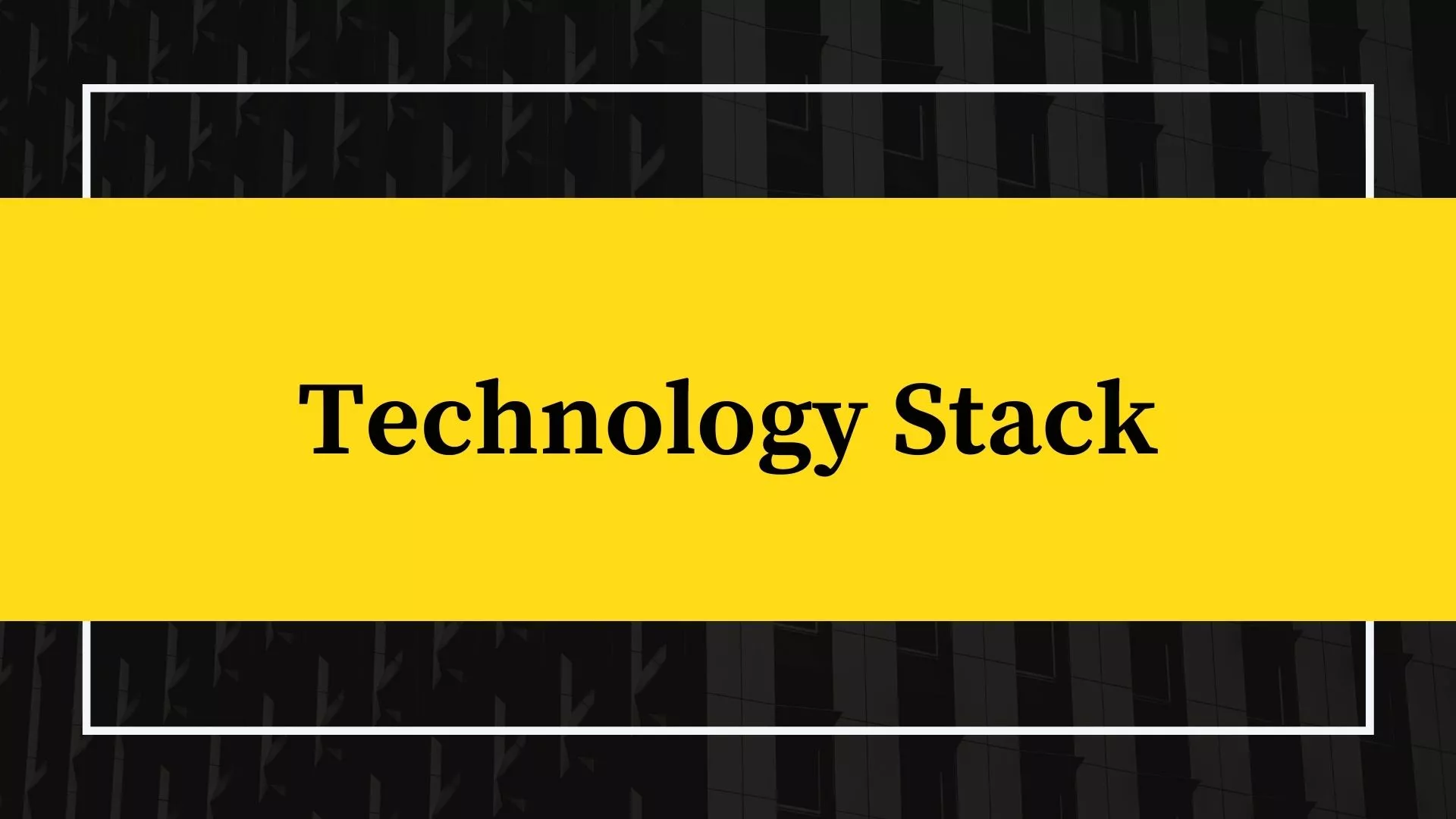How to Fix Discord Error: 'Installation Has Failed'

A technology stack is a set of software products, tools, libraries, frameworks, servers, UI/UX solutions, software, and programming languages that programmers and developers employ to create a web or mobile application. We can refer to the technology stack as a solution stack or simply as a tech stack.

A tech stack is formed when each application layer is built on top of the others, allowing programmers or developers to customize the application to their specific needs. Furthermore, no two technology stacks are alike. For example, Facebook's tech stack may differ from Google's tech stack, and Microsoft's tech stack may differ from other companies' tech stacks.
First, the project is chosen, and then the technology stack is chosen based on the project. And this is a critical step before developing any software. They will then choose the appropriate framework and language and build the application.
Choosing a technology stack can vary from project to project. If you want to create an Enterprise Application, such as a School Management System, you can use Asp.net/ Java for the backend, and Vuejs/Angular/React for the frontend. If your project necessitates a significant amount of AI and machine learning, you can use Python as the backend and any other language as the frontend.
Furthermore, people claim that Ruby and JavaScript are ideal for website development; Java, C#, and C++ are frequently used in financial trading. For statistical analysis, Python and R are the go-to tools. Programming languages frequently make compromises in terms of comfort, security, and speed. And, once again, the choice of programming language is largely in the hands of the developers.
While building any application, there will be two software components:
The server-side or backend technologies stack is comprised of servers, application, and operating systems, databases, and backend programming languages. It contains your product's entire business logic. It is not visible to the user and is responsible for powering the frontend.
1 Operating System: The operating system is the place where software is created. It could be Windows, Linux, or a Mac.
2 Web Server: The web server handles requests from applications and returns the appropriate content. It could be IIS, Nginx, or Kestrel, for example.
3 Database: Databases are used to store, manage, and retrieve applications. It could be MySql, MS SQL (SQL Server), Postgresql, or another database.
4 Backend Programming Language: Backend Programming Language is used to create applications. It could be C#, Java, Python, or another language.
5 Cloud Infrastructure Services: These are the hardware and software component needed for cloud computing. Some of the popular cloud infrastructure and service providers are AWS, Azure, Google Cloud, etc.
Some popular programming languages and their Framework
| Language | Framework |
| C# | .Net , .Net Core |
| PHP | Laravel, Zend, Code Igniter,Symfony,Cake PHP,Yii |
| Python | Django,Flask,CherryPy,Web2py,Bottle |
| JavaScript | Vuejs,Jquery,Angular,React,Ionic,Webkit,PureMVC |
| Java | Spark, Apache Wicket, Grails,Vaadin |
The term "front end" refers to everything on your screens that users see. It is the interface through which the user interacts with the application. Front End Developers are responsible for making sure that websites/web apps are interactive and easy to read. The front end is typically created using HTML, CSS, and Javascript.
1 HTML: HTML stands for HyperText Markup Language and is responsible for content structuring and placement.
2 CSS: CSS stands for style sheet language. It basically describes how the HTML-created document should appear on the user's screen. It contains colors, fonts, background materials, design features, etc.
3 Javascript: Javascript is a scripting language that is commonly used to make websites interactive.
The most popular CSS Frameworks used in Frontend Development are BootStrap, Foundation, Materialize, Bulma, Pure CSS, Stylus, and others.

Fig: Popular CSS Framework
Most of the popular Javascript frameworks used in the Frontend Development are Jquery, VueJs, AngularJs, ReactJs, etc.
There is numerous tech stack in the market and let's discuss some of them in brief.
The LAMP stack is comprised of Linux (i.e. an operating system), Apache (HTTP Server), MySQL (database), and PHP (Server Side Programming). Typically used when developing a server-side application in PHP/Perl/Python.

All 4 components in the LAMP stack are free and open-source. There is no license required to use them.No locked by any vendor. Also. LAMP Stack is a Secure and Stable Platform managed by a large open community. Scalability is another advantage. There are infinite scalability options for the LAMP stack.
How does LAMP Stack work?
Here, I am explaining on the basis of PHP programming Language. The user first requests the page by typing it into the web browser. It is sent to Apache by the web browser. When Apache Web Server discovers that it is a PHP file, it sends it to PHP Engine, which interprets the request and, if a database call is required, PHP makes a MySql Database call. After receiving the response from the database, PHP Engine sends a response back to Apache Server, which sends it to browsers, and the user sees the response on their web browser.
LAMP is the most popular stack model. Other LAMP alternatives include:
These all Alternatives are also free and open source.
XAMPP is cross-platform(X), which means it works equally well on Linux, Windows, and Mac. It includes the Apache HTTP Server, the MariaDB database, PHP, and Perl as Server-Side Languages.
WINS Stack includes Windows Server, Internet Information Services, .Net, SQL Server). Generally used for building application using C# programming language.

4 MEAN Stack
MEAN Stack Includes MongoDB as NoSQL database, Express.js as backend web framework, Angular.js as frontend framework, and Node.js as server-side programming.

5 MERN Stack
MEAN Stack Includes MongoDB as NoSQL database, Express.js as backend web framework, React.js as frontend framework, and Node.js as server-side programming.

6 MEVN Stack
MEAN Stack Includes MongoDB as NoSQL database, Express.js as backend web framework, Vuejs as frontend framework, and Node.js as server-side programming.
7 Serverless Stack
Serverless Stack is one of today's best choices for developers because they should not have to deal with administrative complexity much.
AWS Lambda and Google Cloud provide serverless Stack.
With so many web development tools, platforms, and stacks to choose from, selecting the right technology stack for your project can appear to be a difficult task. The following factors influence the selection of the appropriate technology stack approach.
1 Project Size and Types
Choosing the right technology stack highly depends on your project size and type.
Small Project Size: Small projects are those that require an individual or a small team to complete within a week. The emphasis in Small Projects is primarily on "getting things done." For example, if you have a small project like a portfolio page, you can use a simpler ready-made solution like wix.com or wordpress.com.
Large Project Size: A large project is one that requires large teams to work on it and is an ongoing project. Building social networking sites, such as Facebook, is an example of this type of project. It must be highly scalable, maintainable, and have a high speed. It employs a diverse set of tools, techniques, and languages, among other things.
Medium Project Size: A medium project is one that requires fewer resources than a large project but more than a small project. This category includes enterprise applications such as school management systems, payroll systems, and so on. It will primarily use one technology stack to complete the project. MEAN or LAMP stacks are two examples.
2 Time to Market
Time to market (TTM) is the amount of time it takes for a product to be designed and developed before it is available for sale. If that is the case, one of the most important factors is how much developer expertise is working on the project. How well developers are acquainted with the tools and language used in the technology stack; if they are acquainted, TTM is on a shorter time frame.
3 Development and maintenance cost
The cost of development is directly related to the technology stack. It includes developer salaries, maintenance costs, hosting product costs, software licensing costs (some tools and frameworks are open-source and free, while others are proprietary and require a fee), and distribution costs.
If the cost of production is high, a reasonable price for the product cannot be determined in the market. However, if the cost of production is low, a reasonable price can be set. The cost of production and maintenance varies from technology stack to technology stack.
The longer the code, the more difficult it is to process and maintain, so the code must be short and clear, potentially reducing development and maintenance time and cost.
The better and more consistent the code is written, and the better the system is designed, the easier it will be to adapt as the business grows. Later on, when it comes to maintenance, any developer will understand the wisely written code and will find it easier to maintain.
4 Scalability
Products need a well-defined scalability matrix, which should work well vertically or horizontally.
When your product starts to gain traction, performance is critical. To improve performance, you should prioritize selecting a technology stack that is highly scalable.
Whatever product you are developing will be simple at first. However, as you begin to add modules and the product's traffic grows, your product may become a burden. So, when deciding on the best technology stack, use caution.
5 Security
The security level of each technology stack may differ. So, choose your technology stack wisely.
6 Maintainability
Maintainability is one of the important factors of the technology stack to success. If you can maintain balance in the resources even when scaling to the next level with the same effort level then it is okay.
Some of the benefits of choosing the right technology stack are as follows:

Some of the drawbacks of choosing the wrong stack are as follows:
FAQ:
Ans: Technology Stack is not only software. They are a collection of software products, tools, libraries, frameworks, servers, user interface/user experience (UI/UX) solutions, software, and programming languages.
Ans: No Python is not a tech stack. It is a programming language popularly used in data science.
Ans: Flutter is a technology stack tool in the Cross-Platform Mobile Development category. It is not considered a complete tech stack.